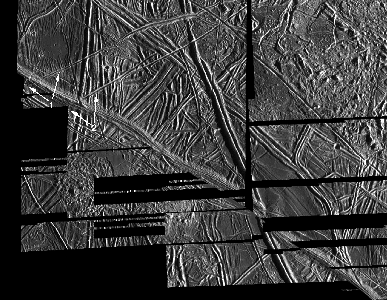

Fig. 2a. Class 2 ridge C2a.
"Ridge C2a" is a Class 2 ridge in the Greenberg et al. (1998a) taxonomy, identified by its raised elevation and its set of thin, parallel subridges arrayed symmetrically on both sides of a prominent medial groove Cg. The ridge is seen here at 35 m/pixel (E4 orbit). Dark lines (Og1, Og2) near the ridge margins may be grooves or ridges associated with an original doublet (Class 1) ridge which parted to form the wider Class 2 ridge. Flanking cracks (F) paralleling the ridge may be due to ridge-induced flexure of the lithospheric plate. Older ridges A, B, and C are apparently disrupted by Ridge C2a, because they are not collinear from one side of the ridge to the other. Arrows connect matching ends of these ridges and describe relative motion required for reconstruction. Ridge B is also a Class 2 ridge, based upon its platform-like morphology.

Fig. 2b. Ridge C2a, reconstructed.
Reconstructed Ridge C2a is shown here. The reconstruction improves the alignment of at least ten older lineaments, including two small cracks (1,2) at the western margin of the image, and creates few gaps or overlaps. Younger lineaments were disrupted by the reconstruction. The ridge opened approximately normal to its trend and thus is dilational, consistent with the ridge-building model of Greenberg (1998a). The lineament is a gap in the lithosphere, rather than a graben, shown because it closed by its full width in this reconstruction. The straight path of the lineament suggests that it formed from a near-vertical crack, also consistent with Greenberg (1998a).